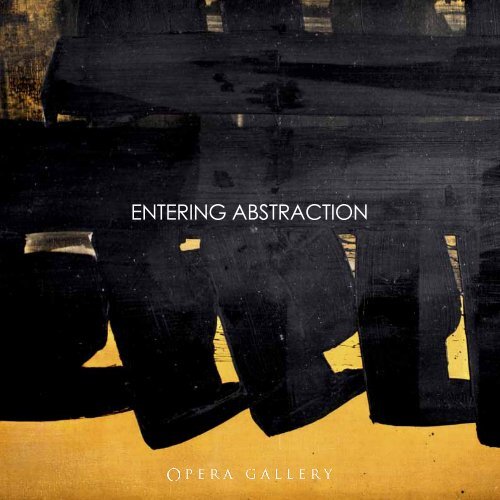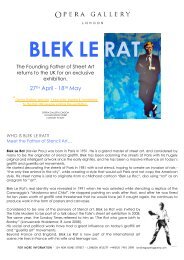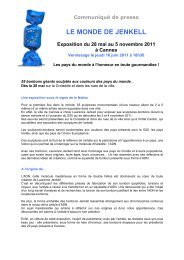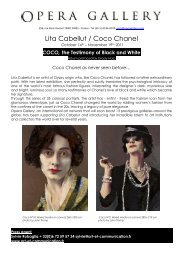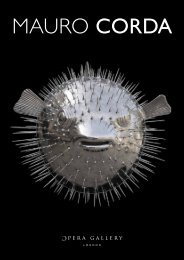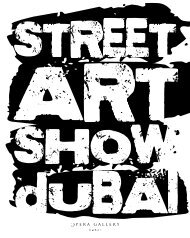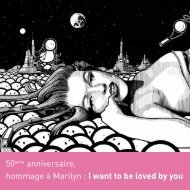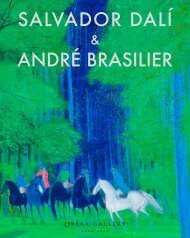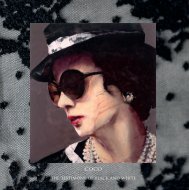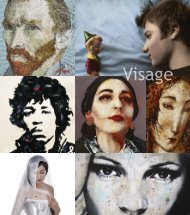Download catalogue - Opera Gallery
Download catalogue - Opera Gallery
Download catalogue - Opera Gallery
Create successful ePaper yourself
Turn your PDF publications into a flip-book with our unique Google optimized e-Paper software.
entering abstRaction
Avant-propos<br />
Foreword<br />
L’art abstrait apparaît au début du XX ème siècle et c’est une véritable révolution : l’art n’a plus<br />
besoin de représenter la réalité. Certes, des formes non figuratives avaient été utilisées bien avant,<br />
mais elles étaient vouées à des fins purement décoratives ou d’embellissement. Le courant abstrait<br />
s’annonce avec les Impressionnistes qui ne cherchent plus seulement à faire une représentation<br />
fidèle de la réalité mais à exprimer les impressions fugitives, puis un peu plus tard, avec les Fauves<br />
qui jouent audacieusement avec les couleurs. Viennent ensuite les Cubistes qui fragmentent leurs<br />
sujets en formes géométriques.<br />
De ces mouvements et recherches découla l’idée que les couleurs, les formes et les textures<br />
pouvaient elles-mêmes devenir le « sujet » d’une œuvre d’art. Les véritables pionniers de l’art<br />
abstrait sont Kandinsky, Kupka, Malevitch et Mondrian qui dès les années 1910 peignent des images<br />
où toute référence au monde extérieur est délibérément supprimée. L’art abstrait devient un<br />
phénomène mondial après 1945 et plusieurs formes apparaissent : abstraction géométrique,<br />
expressionisme abstrait, tachisme, op art, minimalisme, etc.<br />
Mais qu’est ce qui fait qu’une œuvre d’art qui ne représente rien en particulier puisse être aussi<br />
captivante ? L’art abstrait fait appel à l’interprétation personnelle, à l’imagination. Bien sûr on peut<br />
dire cela de toute œuvre d’art, mais la raison pour laquelle l’art abstrait a le potentiel d’être si<br />
puissant c’est que c’est une forme d’art qui permet à l’esprit de vagabonder en s’affranchissant de<br />
toute référence consciente. On n’est pas guidé, on n’a plus de références, chacun interprète à sa<br />
façon les formes, les couleurs et la texture d’une œuvre abstraite. On regarde une œuvre d’art<br />
abstraite un peu comme on écoute un morceau de musique, on n’essaie pas d’identifier les notes,<br />
on se laisse simplement emporter par la mélodie.<br />
<strong>Opera</strong> <strong>Gallery</strong> Genève a sélectionné pour vous plus d’une trentaine d’œuvres abstraites d’artistes<br />
modernes et contemporains du monde entier. Nous sommes heureux de vous inviter à entrer dans<br />
l’abstraction comme on plonge dans un océan de formes et de couleurs et à vous laisser bercer par<br />
ses vagues, transporter par ses courants…<br />
Abstract art appeared at the beginning of the 20 st century and it was a genuine revolution: art<br />
didn’t need to represent reality anymore. Of course, non-figurative patterns had been used long<br />
before, but they were solely for decoration or embellishment. The abstract movement shaped up<br />
with the Impressionists, who not only voluntarily didn’t try to do a faithful depiction of reality but<br />
reflected momentary impressions. A bit later the Fauvists played with colours boldly and then the<br />
Cubists fragmented their subject in geometrical shapes. From all of these movements the idea that<br />
colour, form and texture could be the “subject” of the painting. The pioneers of abstract art as<br />
we know it today were Kandinsky, Kupka, Malevitch and Mondrian, who as early as 1910 painted<br />
images where nothing deliberately referred to the real world. Abstract art spread worldwide after<br />
1945 and different movements emerged: geometrical abstraction, abstract expressionism, op-art,<br />
dripping, minimalism…<br />
How can something that represents nothing in particular be so eye-catching to look at? Abstract<br />
art is open to interpretation and stimulates our imagination. Of course, one could say that about<br />
any work of art but the reason why abstract art has the potential to be so powerful is that it lets<br />
the mind wander freely, keeping the conscious distractions to a minimum. We are not guided, there<br />
are no references, we are free to explore the artwork and assign our own meaning to the shapes,<br />
colours and texture of the piece. We look at abstract art in the same way that we listen to music,<br />
we don’t try to hold on to the notes, but we let the melody wash over us.<br />
<strong>Opera</strong> <strong>Gallery</strong> Geneva has carefully selected for you over thirty pieces of abstract art by modern<br />
and contemporary artists from all over the world. We are pleased to invite you to enter abstraction<br />
the way you would dive in an ocean of shapes and colours. Let yourself be lulled by the rhythm of<br />
its waves, be carried away by its currents…<br />
Jordan Lahmi<br />
Directeur<br />
<strong>Opera</strong> <strong>Gallery</strong> Genève<br />
Gilles Dyan<br />
Fondateur et Président<br />
<strong>Opera</strong> <strong>Gallery</strong> Group<br />
Jordan Lahmi<br />
Director<br />
<strong>Opera</strong> <strong>Gallery</strong> Geneva<br />
Gilles Dyan<br />
Founder and Chairman<br />
<strong>Opera</strong> <strong>Gallery</strong> Group
Fernand Léger<br />
(1881 - 1955)<br />
Fantaisie sur fond rouge, 1943<br />
Signed and dated ‘F.Leger 54’ (lower right corner); countersigned, titled<br />
and dated ‘Fantaisie sur fond rouge F.Leger 43’ (on the reverse)<br />
Oil on canvas board<br />
61 x 50 cm - 24 x 19.7 in.<br />
Provenance<br />
Perls Galleries, New York<br />
Collection of Mr. and Mrs. Berny Schulman, Glencoe, Illinois<br />
Sale: Sotheby’s New York, Oct. 23, 1980, lot 265<br />
Private collection<br />
Sale: Sotheby’s New York, May 16, 1990, 101 438<br />
Leonard Hutton Galleries, New York<br />
Private collection, New York<br />
Exhibited<br />
New York, Perls Galleries, Modern French Painting, 1952, No. 82<br />
Literature<br />
Georges Bauquier, Fernand Léger: Catalogue raisonné de l’œuvre peint,<br />
Paris, 1998, vol. 6, p. 270, No. 1144, ill. in colour p. 271<br />
Certificate<br />
Georges Bauquier, director of Musée National Fernand Léger has<br />
confirmed the authenticity of this work
Alexander Calder<br />
(1898 - 1976)<br />
Three lights and five blacks, 1956<br />
Signed and dated ‘Calder 56’ (lower right corner)<br />
Oil on canvas<br />
55,9 x 81,3 cm - 22 x 32 in.<br />
Provenance<br />
Gift of the artist<br />
Talcott and Polly Clapp, Connecticut<br />
Private collection, New York<br />
Exhibited<br />
New York, Perls Galleries, Calder, Feb. 6 - March 10, 1956<br />
New York, Tina Kim <strong>Gallery</strong> in conjunction with Vintage 20,<br />
Alexander Calder and George Nakashima, May 22 - June 28, 2008<br />
Certificate<br />
This work is registered in the archives of the Calder Foundation,<br />
New York, under the reference No. A10411
Joan Miró<br />
(1893 - 1983)<br />
Oiseaux dans l’espace, 1960<br />
Signed ‘M’ (lower left corner); countersigned, dated<br />
and inscribed ‘MIRÓ 29/1/60 oiseaux dans l’espace’ (on the reverse)<br />
Mixed media on paper<br />
50 x 65 cm - 19.7 x 25.6 in.<br />
Provenance<br />
Galerie Beyeler, Basel, No. 7398<br />
Private collection, Italy<br />
Certificate<br />
Jacques Dupin has confirmed the authenticity of this work
Georges Mathieu<br />
(1921 - 2012)<br />
Hudson bay, 1963<br />
Signed and dated ‘Mathieu Georges 63’, titled ‘Hudson bay’ (on the stretcher)<br />
Oil on canvas<br />
97 x 194 cm - 37 x 76.4 in.<br />
Provenance<br />
Dominion <strong>Gallery</strong>, Montreal<br />
Private collection, Paris<br />
Exhibited<br />
Montreal, Dominion <strong>Gallery</strong>, Mathieu, 1963<br />
Literature<br />
Vie des Arts, Montréal, No. 31, summer 1963, ill. p. 32
André Lanskoy<br />
(1902 - 1976)<br />
Les Joies des autres, 1960<br />
Signed ‘LANSKOY’ (lower right); titled in French and Russian,<br />
inscribed and dated ‘les joies des autres Roquereine 60’<br />
(on the reverse)<br />
Oil on canvas<br />
97 x 146 cm - 38.2 x 57.5 in.<br />
Provenance<br />
Galerie Louis Carré et Cie., Paris<br />
Svensk-Franska Galleriet, Stockholm<br />
Private collection, London<br />
Literature<br />
This work will be included in the forthcoming André Lanskoy<br />
Catalogue raisonné being prepared by André Schoeller
Serge Poliakoff<br />
(1900 - 1969)<br />
Composition abstraite, circa 1966-67<br />
Signed ‘Serge Poliakoff’ (lower left corner)<br />
Oil on canvas<br />
130 x 97 cm - 51.2 x 38.2 in.<br />
Provenance<br />
Marcelle Poliakoff collection<br />
Galerie Melki, Paris<br />
Private collection, France<br />
Certificate<br />
This work is registered in the Archives Poliakoff under the<br />
reference No. 967033
Pierre Soulages<br />
(1919 -)<br />
Peinture 73,5 x 92 cm, 16 novembre 1970<br />
Signed ‘Soulages’ (lower left corner) and dated ‘16 novembre<br />
1970’ (on the reverse)<br />
Oil on canvas<br />
73,5 x 92 cm - 28.9 x 36.2 in.<br />
Provenance<br />
Gimpel-Weitzenhoffer <strong>Gallery</strong>, New York (1972)<br />
Gimpel Fils <strong>Gallery</strong>, London (1972)<br />
Moos <strong>Gallery</strong>, Toronto (1987)<br />
Collection Barry Miller, London (1987)<br />
Galerie Melki, Paris, 1992<br />
Arnold Herstand <strong>Gallery</strong>, New York<br />
Exhibited<br />
Charleroi, Pierre Soulages, 1973<br />
New York, Gimpel-Weitzenhoffer <strong>Gallery</strong>, Pierre Soulages, 1977<br />
Literature<br />
Pierre Encrevé, Soulages, complete work, paintings, Editions du<br />
Seuil, Paris, 1994, Vol. II, No. 662, p. 238
Pierre Soulages<br />
(1919 -)<br />
Peinture 222 x 85 cm, 30 décembre 2002<br />
Signed, titled and dated ‘Soulages Peinture 222 x 85 cm<br />
30 Dec 2002’ (on the reverse)<br />
Oil on canvas<br />
222 x 85 cm - 87.4 x 33.5 in.<br />
Provenance<br />
Galerie Karsten Greve, Paris<br />
Private collection, Switzerland<br />
Exhibited<br />
Paris, Galerie Karsten Greve, Pierre Soulages, Peinture<br />
1999-2002, ill. in colour p. 43<br />
Hans Hartung<br />
(1904 - 1989)<br />
T1985 - H13, 1985<br />
Signed and dated ‘HH 1985’ (lower left)<br />
Acrylic on canvas<br />
130 x 102 cm - 51.2 x 40.1 in.<br />
Provenance<br />
Galerie Bodenschatz, Basel<br />
Galerie Daniel Gervis, Paris<br />
Literature<br />
This work will be included in the forthcoming Catalogue raisonné, being prepared by the<br />
Hans Hartung Fondation and Anna-Eva Bergman<br />
Certificate<br />
This work is registered by the Hans Hartung Foundation under the reference No. HH145
Gérard Ernest Schneider<br />
(1896-1986)<br />
Untitled, 1972<br />
Acrylic on paper<br />
106 x 73 cm - 41.7 x 28.7 in.<br />
Provenance<br />
Galerie Ditesheim, Neuchâtel<br />
Zao Wou-ki<br />
(1921 - 2013)<br />
02.05.2004<br />
Signed and dated ‘Zao Wou-ki 2004’ (lower right); signed and titled<br />
‘ZAO WOU-KI 2/2004 Mai’ (on the reverse)<br />
Oil on canvas<br />
65,5 x 81,3 cm - 25.8 x 32 in.<br />
Provenance<br />
Acquired directly from the artist<br />
Private collection, Paris<br />
Certificate<br />
Zao Wou-Ki has confirmed the authenticity of this work
Willem De Kooning<br />
(1904 - 1997)<br />
Composition, 1973<br />
Signed ‘De Kooning’ (lower left)<br />
Oil and acrylic on newspaper<br />
37 x 29 cm - 14.6 x 11.4 in.<br />
Provenance<br />
Private collection, Europe
Robert Motherwell<br />
(1915 - 1991)<br />
Blue with crosses<br />
Oil on canvas<br />
137,1 x 96,5 cm - 54 x 38 in.<br />
Provenance<br />
Private collection, New York<br />
Certificate<br />
The Dedalus Foundation, Inc., has confirmed the authenticity of this work
Karel Appel<br />
(1921-2006)<br />
Deux personnages, 1963<br />
Signed ‘Appel’ (lower left corner)<br />
Oil on canvas<br />
91,4 x 152,4 cm - 36 x 60 in.
Victor Vasarely<br />
(1906 - 1997)<br />
Citra, 1955-1959<br />
Signed ‘Vasarely’ (lower centre); countersigned twice, titled and dated ‘Vasarely Citra 1955-<br />
1959’ (on the reverse)<br />
Provenance<br />
Galerie Denise René-Hans Mayer, Düsseldorf (1972)<br />
Exhibited<br />
Stuttgart, Württ, Kunstverein, No. 344/1<br />
Literature<br />
Marcel Joray, Plastic Arts of the 20 th Century, Editions du Griffon, Neuchâtel, 1965, vol. I,<br />
similar artwork, No. 130, ill. p. 116
Yayoi Kusama<br />
(1929 -)<br />
Waves on the lake, 1988<br />
Signed, titled and dated (on the reverse)<br />
Acrylic on canvas<br />
53 x 45,5 cm - 20.9 x 17.9 in.<br />
Certificate<br />
The Yayoi Kusama Studio has confirmed<br />
the authenticity of this work<br />
Flames, 1990<br />
Signed, titled and dated (on the reverse)<br />
Acrylic on canvas<br />
53 x 45 cm - 20.9 x 17.7 in.<br />
Certificate<br />
The Yayoi Kusama Studio has confirmed<br />
the authenticity of this work
Andy Warhol<br />
(1928 - 1987)<br />
Camouflage, 1986<br />
Synthetic polymer paint and silkscreen on canvas<br />
30,5 x 25,4 cm - 12 x 10 in.<br />
Certificate<br />
The Andy Warhol Foundation has confirmed the<br />
authenticity of this work
Anselm Reyle<br />
(1970 -)<br />
Untitled (iridescent box), 2013<br />
Acrylic, glass and mixed media on canvas<br />
182 x 122 x 26 cm - 71.6 x 48 x 10.2 in.<br />
Anish Kapoor<br />
(1954 -)<br />
Untitled, 2011<br />
Stainless steel and gold<br />
130 x 130 x 26 cm - 51.2 x 51.2 x 10.2 in.
David Mach<br />
(1956 -)<br />
Jackson Pollock 2<br />
Mixed media postcards on wood<br />
183 x 183 cm - 72 x 72 in.
Damien Hirst<br />
(1965 -)<br />
Opium, 2000<br />
Signed and numbered ‘Damien Hirst’ (lower right corner)<br />
Lithograph, edition of 500<br />
43 x 48 cm - 16.9 x 18.9 in.
Regina Scully<br />
(1975 -)<br />
In verses<br />
Oil on canvas<br />
91,5 x 122 cm - 36 x 48 in.<br />
Passage<br />
Oil on canvas<br />
137 x 213 cm - 53.9 x 83.8 in.
Edouardo Guelfenbein<br />
(1953 -)<br />
Transient<br />
Acrylic on canvas<br />
146 x 114 cm - 57.5 x 44.9 in.<br />
Jale Celik<br />
(1966 -)<br />
Untitled, 2012<br />
Mixed media on canvas<br />
125 x 125 cm - 49.2 x 49.2 in.
Richard Texier<br />
(1955 -)<br />
Chaosmos, 2011<br />
Acrylic on canvas<br />
146 x 114 cm - 57.5 x 45 in.<br />
Oli G. Johannsson<br />
(1945 -)<br />
56 days in Salo<br />
Acrylic on canvas<br />
145 x 145 cm - 57.1 x 57.1 in.
Hypertrait ‘‘unstable landscapes series’’, 2013<br />
(Hypertext No. 473)<br />
Optics lenses, stainless steel, wood, inkjet ultrachrome k3<br />
on photographic paper, unique piece<br />
80 x 80 cm - 31.5 x 31.5 in.<br />
Umberto Ciceri<br />
(1961 -)<br />
Hypertrait ‘‘square millimeter’’, 2013<br />
(Hypertext No. 510)<br />
Optics lenses, stainless steel, wood, inkjet ultrachrome k3<br />
on photographic paper, unique piece<br />
80 x 80 cm - 31.5 x 31.5 in.
Sakan Kan-no<br />
(1970 -)<br />
Untitled, 2004<br />
Urethane and acrylic on canvas<br />
45 x 91 cm - 17.7 x 35.8 in.
www.operagallery.com<br />
Place Longemalle 10 - 12, 1204 Genève T +41 22 318 5770. geneve@operagaller y.com


